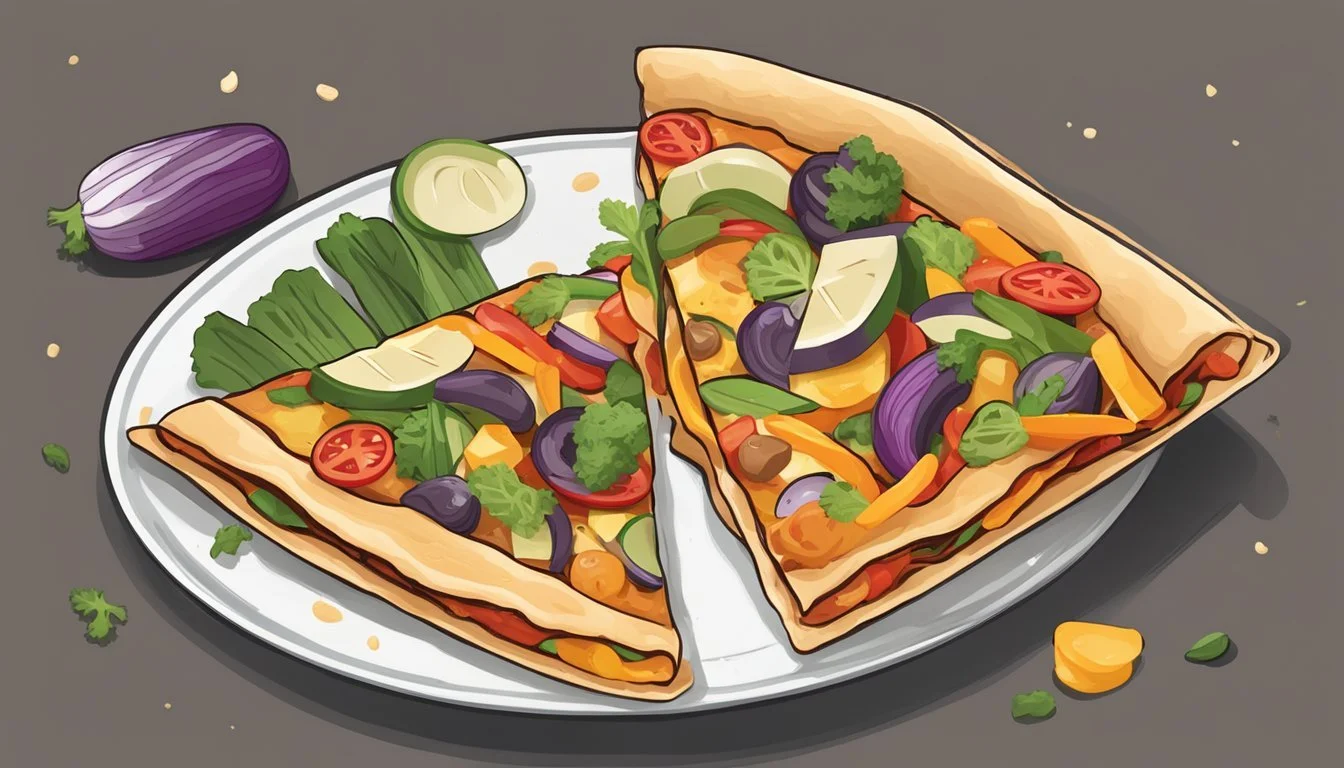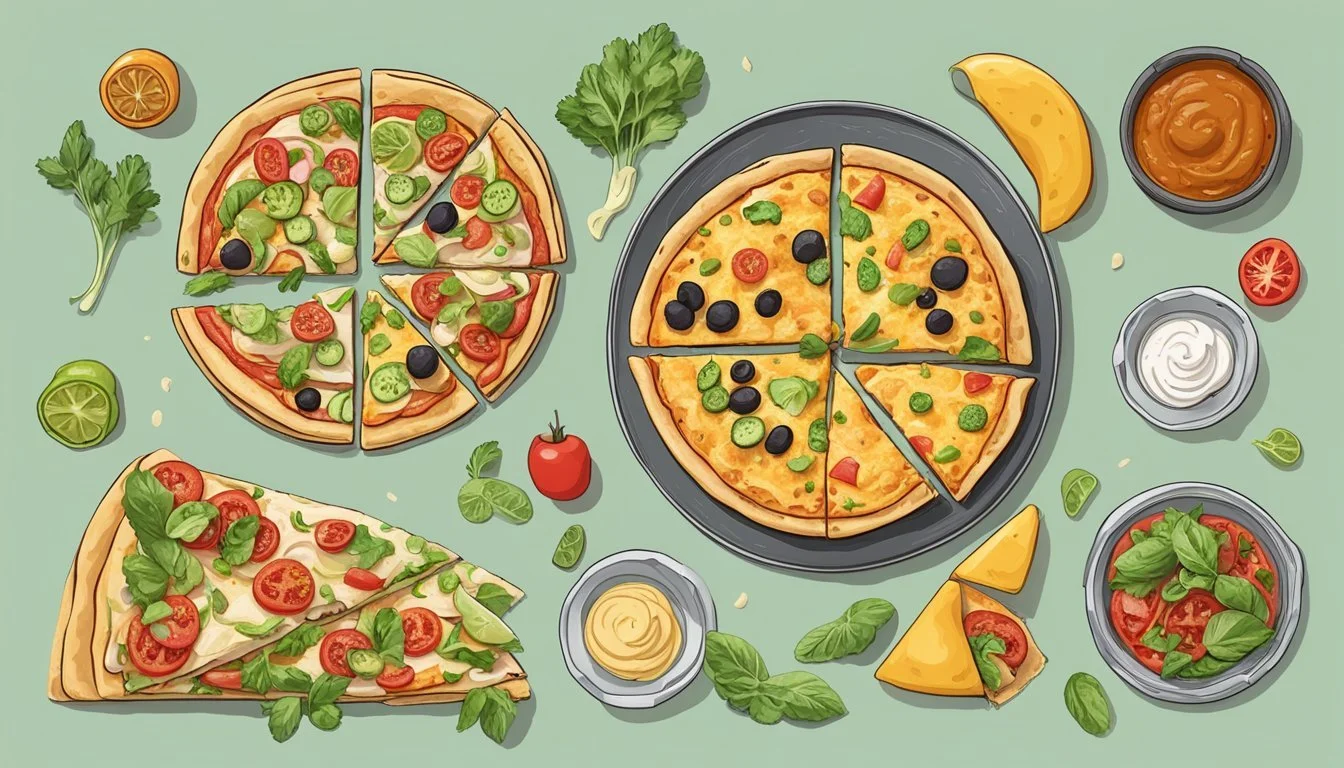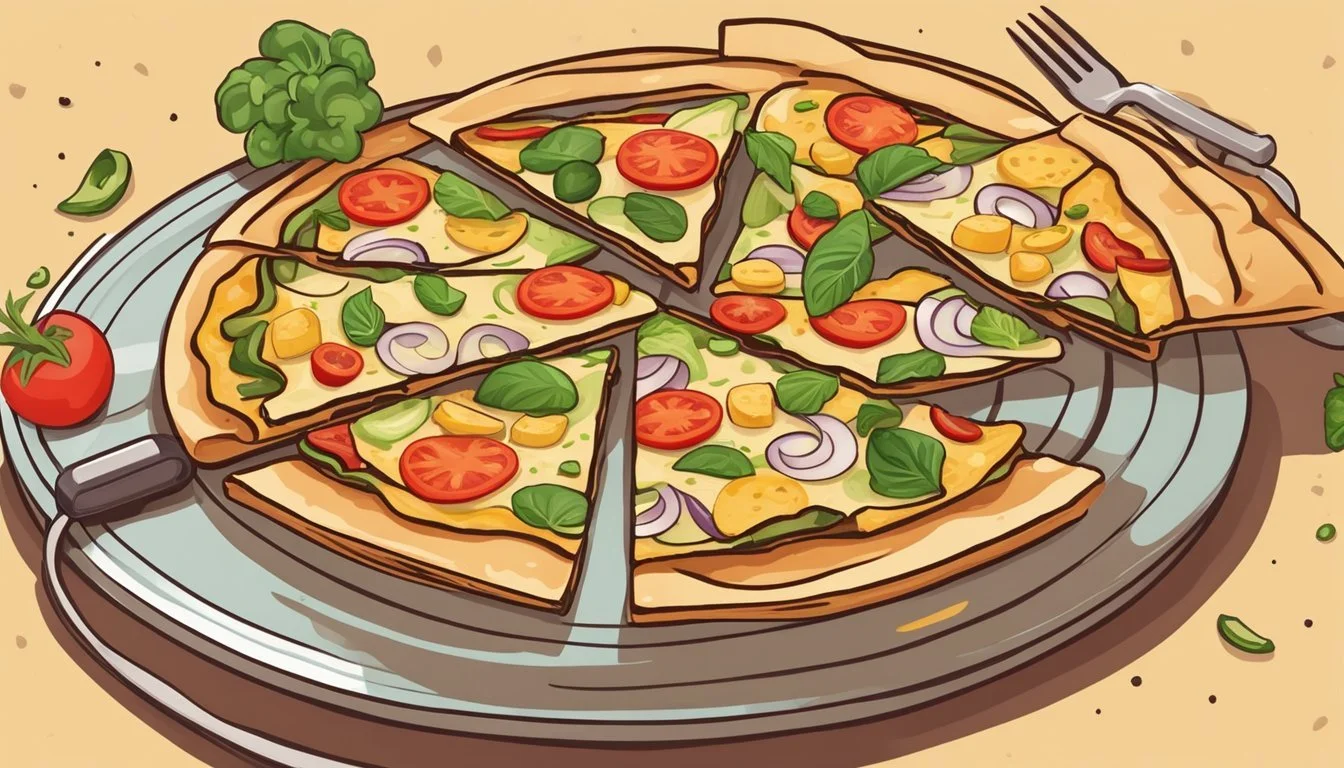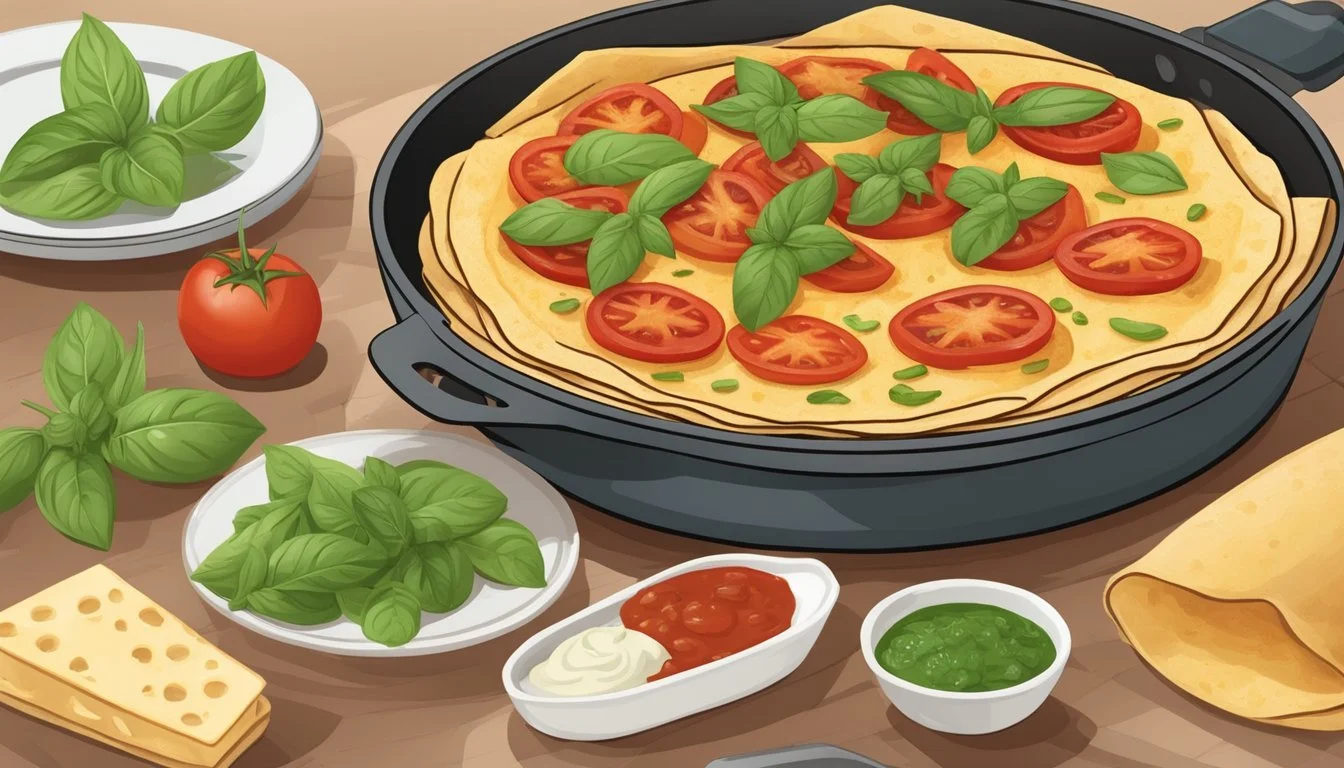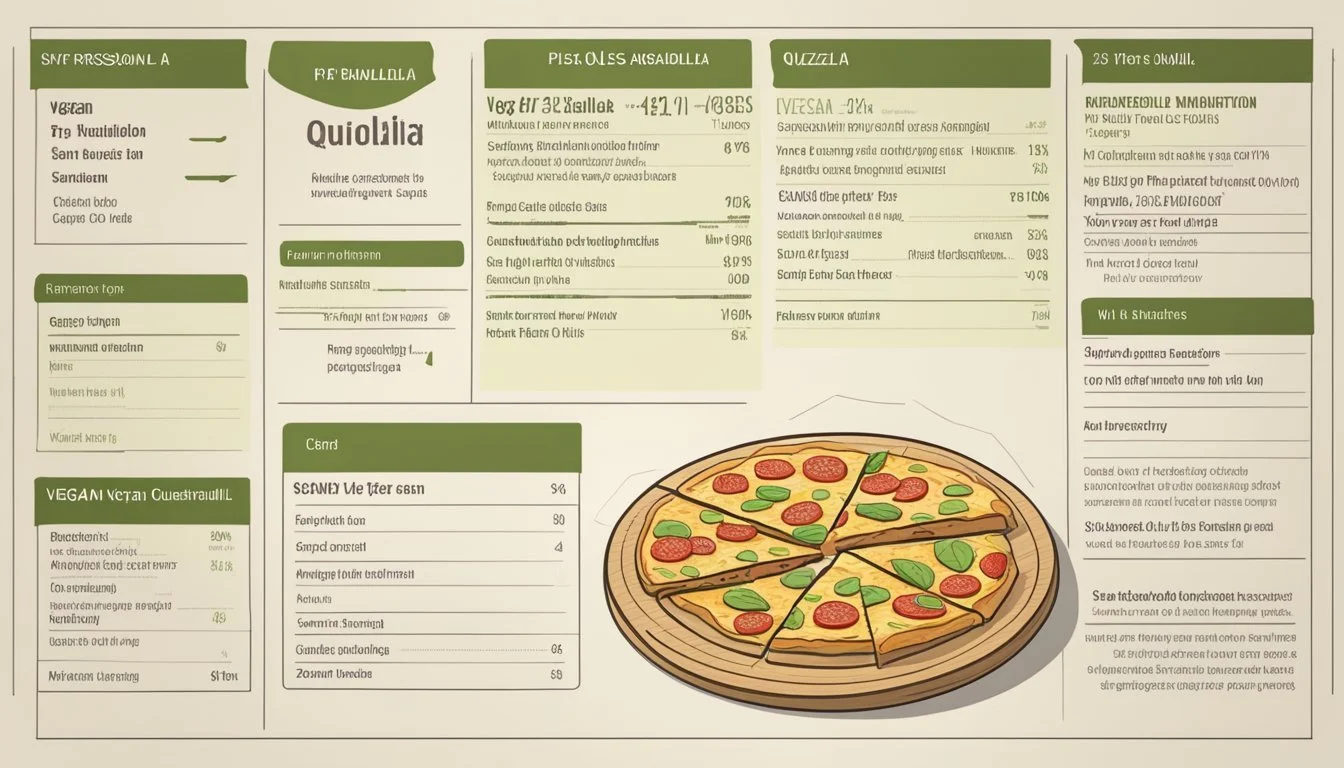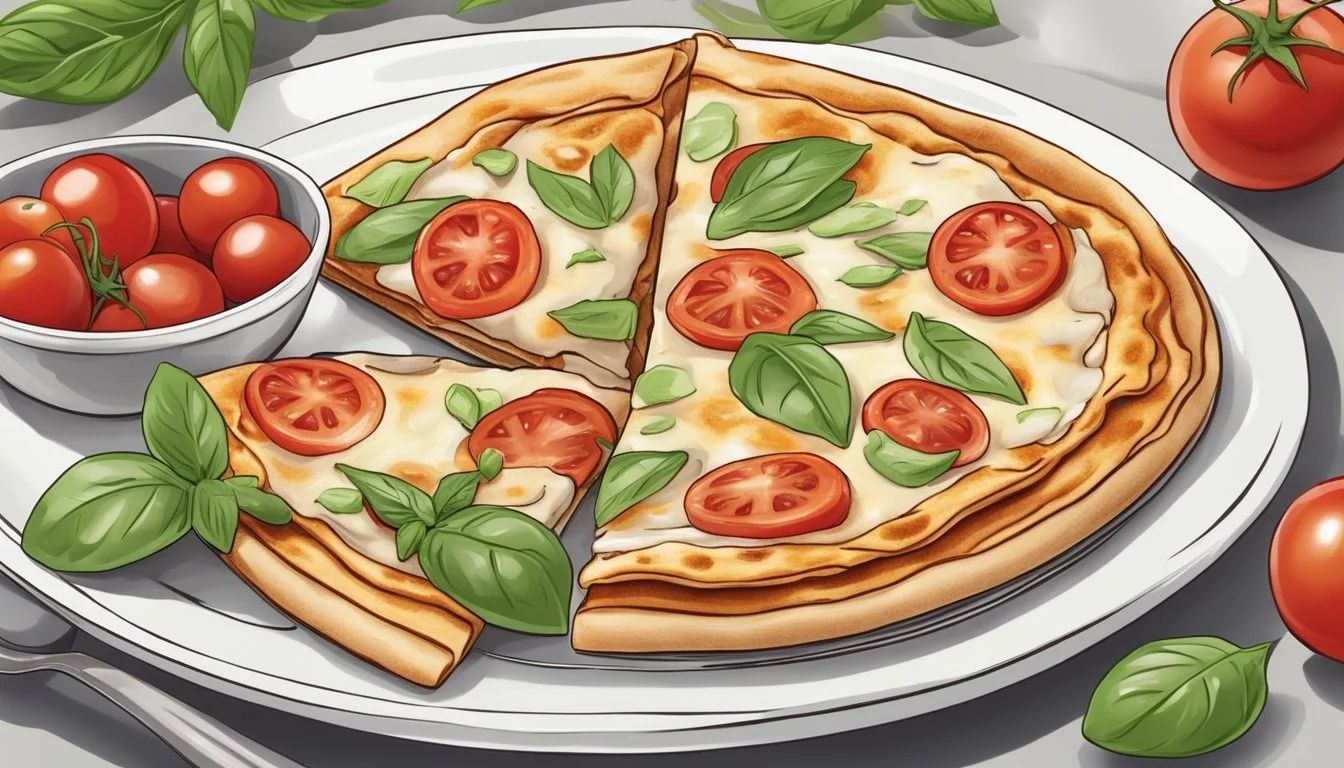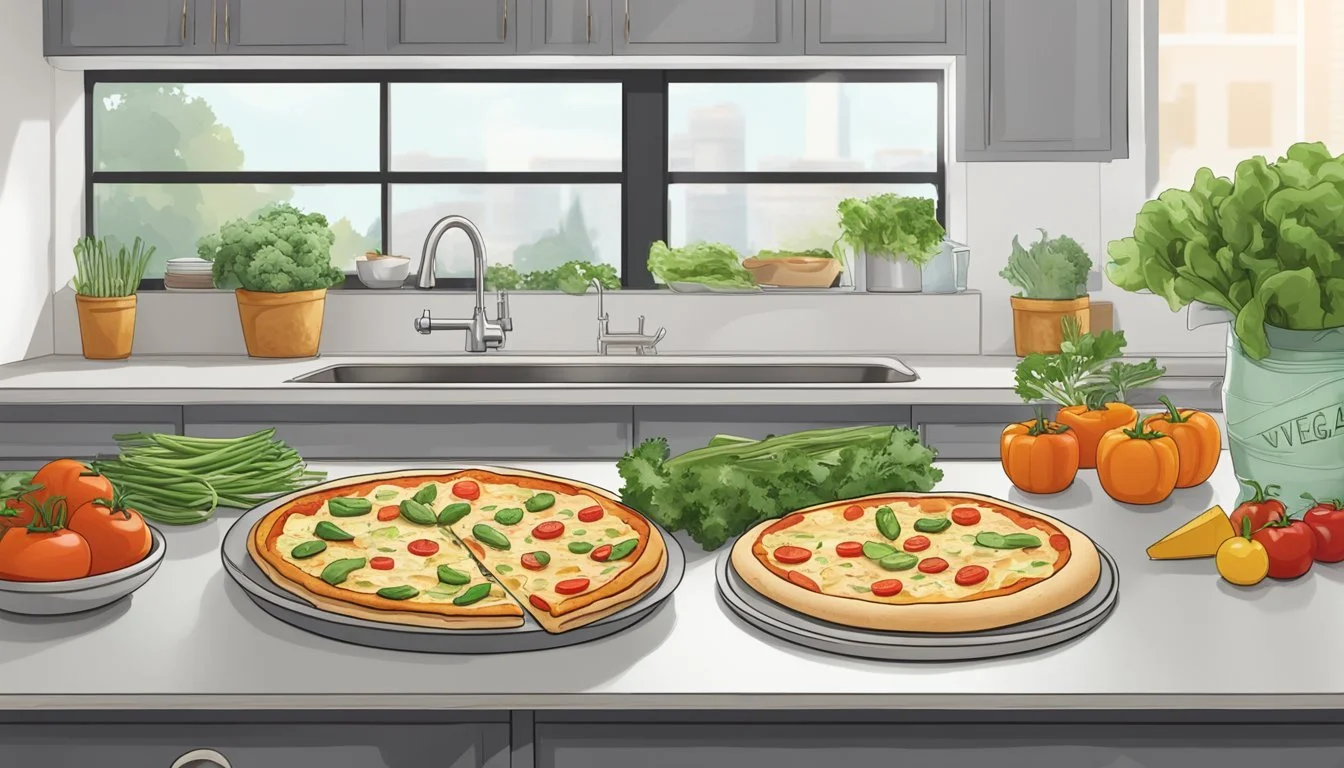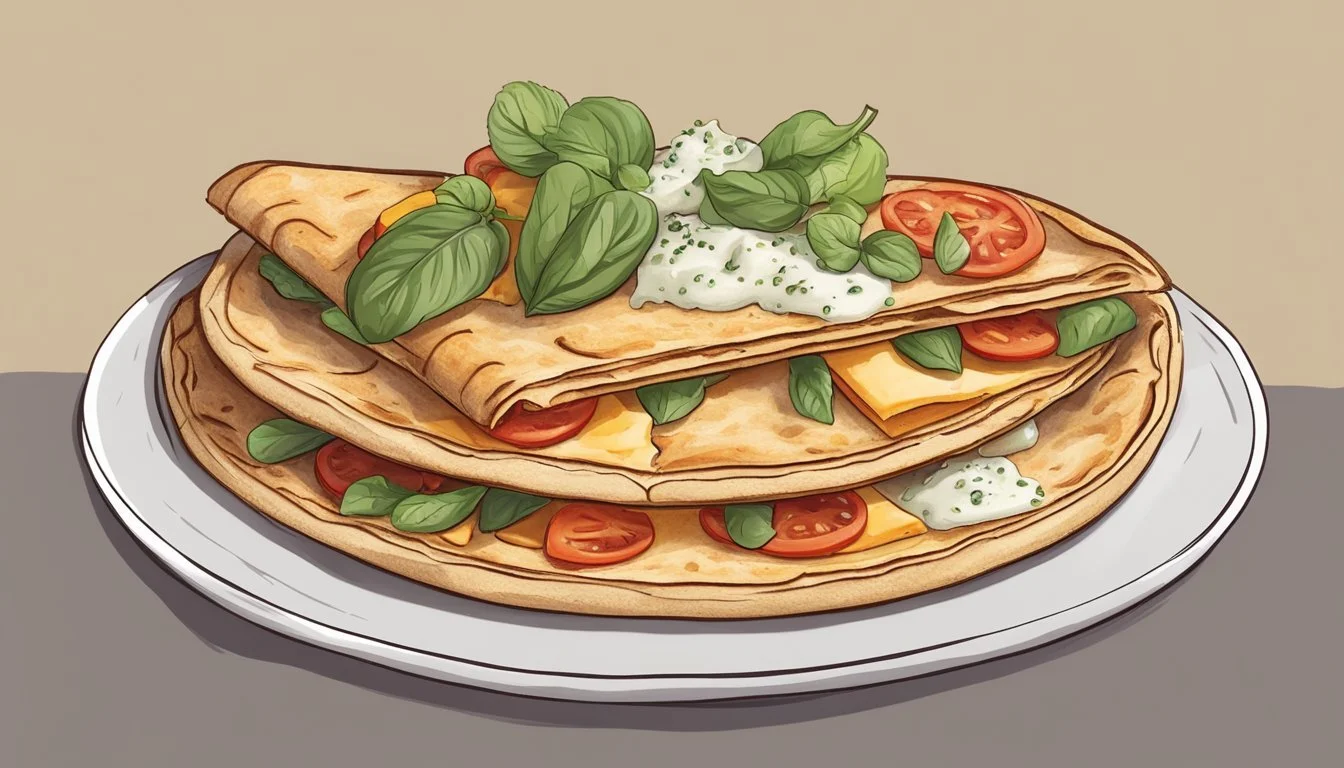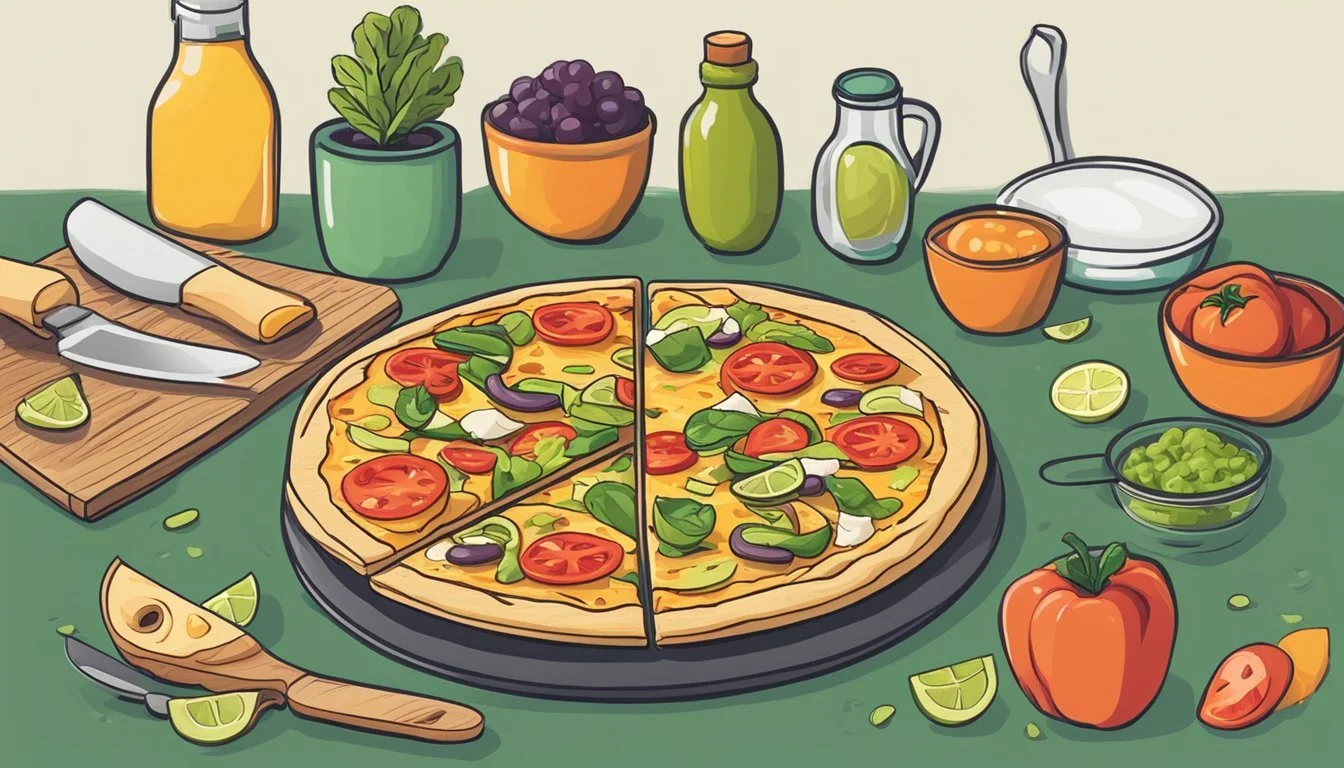Is Pizza Quesadilla Vegan?
Unveiling the Truth About This Popular Dish
The fusion of pizza (What wine goes well with pizza?) and quesadilla into a single dish has given birth to an appetizing hybrid known as the "pizza quesadilla" or sometimes dubbed a "pizzadilla." This culinary creation mirrors the structural essence of a quesadilla, which traditionally involves folding a tortilla in half over a cheese filling and heating it until the cheese melts. The pizza elements are introduced through the addition of pizza toppings like pepperoni, sauce, and cheese. The result is a dish that offers the crispy texture of a quesadilla with the familiar flavors of a pizza.
When questioning whether a pizza quesadilla is vegan, the ingredients chosen are the deciding factor. Standard pizza quesadillas that incorporate dairy cheese and meats such as pepperoni are not suitable for a vegan diet. However, the dish is highly adaptable and can easily be made vegan by selecting plant-based cheese alternatives, meat substitutes like vegan pepperoni, and vegetable toppings. Vegan pizza quesadillas may also favor ingredients such as guacamole, vegan sour cream, or cashew-based sauces to enhance flavor without compromising on the vegan principles.
The culinary landscape has embraced versatility, particularly within vegan cuisine, allowing for creative plant-based versions of classic dishes. While vegan pizza quesadillas might not be as readily available in all eateries, they are becoming a more common sight on menus and in recipe databases, reflecting a growing demand for vegan options that do not sacrifice taste or texture. With the right substitutions, pizza quesadillas can be enjoyed by vegans and those seeking to explore plant-based alternatives to traditional comfort foods.
Understanding Veganism
Veganism is a dietary and lifestyle choice that excludes all forms of animal products. The focus of veganism is on ethical, health, and environmental concerns. This section outlines the core components of the vegan diet, its ingredients, and nutrition fundamentals.
Definition of Vegan
A vegan diet consists of only plant-based foods. It strictly avoids animal-derived products, including meat, dairy, eggs, and honey. This lifestyle extends beyond diet to exclude animal byproducts in clothing, cosmetics, and more.
Vegan Ingredients
Key vegan ingredients form the basis of a nutritious plant-based diet. These include:
Fruits and Vegetables: Rich sources of vitamin A and C, fiber, and minerals.
Legumes: Provide essential protein, iron, and fiber.
Nuts and Seeds: Offer healthy fats (monounsaturated and polyunsaturated), protein, and iron.
Whole Grains: Contribute to daily intake of fiber and B-vitamins.
Vegan Nutrition Essentials
A balanced vegan diet can provide all necessary nutrients, but careful planning is essential. Consider the following:
Protein: Found in legumes (beans, lentils, chickpeas), tofu, tempeh, and plant-based meat alternatives.
Vitamin B12: Usually fortified in plant-based milk, nutritional yeast, or supplements.
Iron: Sourced from leafy greens, legumes, and fortified foods.
Calcium: Found in fortified plant milk, tofu, and leafy greens.
Vitamins: A balanced intake of fruits and vegetables provides vitamins A and C.
Healthy Fats: Essential and derived from nuts, seeds, avocados, and vegetable oils.
It is recommended to combine various protein sources and consume foods rich in vitamin C to improve iron absorption. Regular monitoring of nutrient intake ensures a wholesome vegan diet.
Exploring Quesadillas
Quesadillas are a versatile dish, traditionally non-vegan due to cheese, but they can be adapted to fit a vegan diet through various substitutions and ingredient choices.
Traditional Quesadilla Ingredients
Tortillas: The base of any quesadilla is the tortilla, with flour tortillas being the most common, but corn tortillas are an alternative, especially for a gluten-free option.
Cheese: A key ingredient that provides the quesadilla with its signature melted texture and savory flavor.
Filling: Common fillings include a variety of veggies such as onions, peppers, spinach, mushrooms, and broccoli, alongside proteins like beans.
Vegan Quesadilla Variations
Vegan Cheese: Essential for maintaining the dish's character, with nut-based and soy-based options available for those avoiding dairy.
Additional Ingredients: Vegans can enjoy a quesadilla filled with a rich array of vegetables, beans, and sometimes even vegan mock meats.
Vegan Cheese Alternatives
Type Characteristics Allergen Info Nut-based Creamy and rich, often from cashews or almonds Contains nuts Soy-based Melts well, made from soybeans or soy proteins Contains soy Nut-free Options include coconut or vegetable oils Nut-free, often soy-free Gluten-free Free from wheat, barley, and rye ingredients Gluten-free
Vegan quesadillas can accommodate a wide range of dietary needs while still providing the comfort and joy of the original dish.
The Pizza Twist
The Pizza Twist reimagines the traditional pizza by merging it with a quesadilla, offering a versatile dish that can cater to vegan diets. This fusion combines the hearty base of a pizza with the handy form factor of a quesadilla.
Pizza Quesadilla Composition
A pizza quesadilla consists of two main components: a tortilla that takes the place of the pizza base and the stuffing that includes a variety of ingredients commonly found on pizzas. A vegan pizza quesadilla involves ensuring that every element, from the tortilla to the fillings and the cheese, adheres to vegan standards.
Vegan Pizza Sauce Choices
The heart of the pizza quesadilla is the pizza sauce. For a vegan option, one can choose traditional tomato-based sauces (What wine goes well with tomato-based sauces?) flavored with garlic, basil, and oregano. It's essential to verify the sauce is free of animal by-products, often found in some brands. Moreover, opting for a homemade sauce can further ensure the vegan quality, using ingredients such as:
Crushed tomatoes
Olive oil
Basil
Garlic
Plant-Based Toppings for Pizza Quesadilla
Toppings are what bring diversity and flavor to the pizza quesadilla. Vegan options include:
Vegan cheese: There are numerous varieties made from nuts, soy, and other plant sources.
Plant-based pepperoni: This adds the classic pizza flavor without meat.
Vegetables: Zucchini, bell pepper, mushrooms, and onions offer texture and nutrients.
Additional garnishes: Black olives, salsa, and vegan sour cream can elevate the taste profile.
By carefully selecting the tortilla, sauce, and toppings, one can ensure their pizza quesadilla is completely vegan while still being a delightful, savory treat.
Cooking Techniques
Creating a vegan pizza quesadilla combines culinary precision with simple, plant-based ingredients to offer a delicious twist on traditional quesadillas. The techniques revolve around preparation and achieving a desirable texture, ensuring a golden and crisp final product.
How To Prepare A Vegan Quesadilla
To begin the preparation of a vegan quesadilla, one should select a large tortilla as the base and opt for vegan cheese as the staple ingredient.
Ingredients should be spread evenly, leaving a slight margin along the edge to prevent spillage.
Sautéing vegetables before adding them to the quesadilla adds depth of flavor. Use a skillet with a dash of oil to sauté.
Once the fillings are prepared, fold the tortilla gently to encase the contents, making it ready for cooking.
Prep time typically ranges from 10 to 15 minutes, based on the complexity of the chosen ingredients.
Achieving the Perfect Crisp
The key to a crisp quesadilla is the cooking method and attentiveness during the process.
Heat a dry skillet or griddle over medium heat to ensure the tortilla does not burn.
Place the filled quesadilla on the cookware and press lightly.
Cook each side until the exterior is golden brown, which usually takes three to five minutes.
Alternatively, a baking sheet in a preheated oven can be utilized for an evenly heated environment, enhancing the crispiness without the need for flipping.
Cook time is generally brief, ensuring that the vegan cheese has melted and the tortilla has reached the desired golden crispness. The total time from prep to cook can be estimated at around 20 to 30 minutes, depending on the specific recipe and the number of quesadillas being made.
Nutritional Information
When assessing the nutritional profile of a vegan pizza quesadilla, one must consider the caloric breakdown, the balance of macronutrients, and the content of sodium and sugars. These factors contribute to understanding the dish's healthfulness and how it fits into a balanced diet.
Caloric Breakdown
The calories in a vegan pizza quesadilla can vary depending on the ingredients used. Typically, a serving contains:
Calories: 250-400 kcal
These values stem from the contributions of the tortilla, vegan cheese, vegetables, and potentially other toppings like vegan pepperoni.
Macronutrient Content
A balanced macronutrient distribution is critical for maintaining energy and supporting bodily functions. A standard serving of a vegan pizza quesadilla may generally contain the following macronutrients:
Carbohydrates: 30-50g
Fiber: 2-5g
Proteins: 8-15g
Fat: 10-20g
Saturated Fat: < 5g
The exact figures can fluctuate based on the specific brands of vegan cheese and tortillas used, as well as the variety and quantity of vegetables added.
Sodium and Sugars
Monitoring sodium and sugar intake is important for overall health. A vegan pizza quesadilla may include:
Sodium: 500-1200mg
Sugar: 2-4g
The sodium level can be high due to vegan cheese and added condiments like pizza sauce or buffalo hot sauce. In contrast, sugars are usually low unless sweetened toppings or sauces are applied.
Serving and Presentation
When serving a vegan pizza quesadilla, presentation can enhance the dining experience. The dish should be served hot with attention to aesthetic garnishes and suitable accompaniments that complement its flavors.
Garnishing and Side Dishes
A vegan pizza quesadilla can be garnished with an array of colorful and flavorful toppings. To introduce a fresh component, chefs often opt for a dollop of guacamole or a sprinkle of cayenne pepper for heat. For an added visual appeal, gourmet presentations may feature a light drizzle of vegan salsa around the quesadilla or a delicate sprinkling of chopped herbs.
Side dishes should balance the main's richness with lighter options. A crisp salad adorned with an array of fresh vegetables adds both color and texture to the plate. This combination not only creates a visual feast worthy of being shared on platforms like Instagram but also ensures a well-rounded meal.
Serving Suggestions for Various Audiences
A vegan pizza quesadilla is versatile enough to suit various dining contexts, from a quick weeknight dinner to a casual party appetizer. For adults, consider serving the quesadilla with a side of spicy salsa to cater to a more mature palate. When serving kids, one might cut the quesadilla into smaller, manageable pieces and reduce the spice levels for a more kid-friendly version.
An additional benefit of this dish is the ability to utilize leftovers effectively. Leftover quesadillas can be refreshed by toasting them, ensuring the cheese melds beautifully with the other ingredients for a second serving. Whether for a relaxed family dinner or a meal prep solution, the vegan pizza quesadilla remains an adaptable and satisfying choice.
Storage and Food Safety
Proper storage and reheating methods ensure that leftover vegan quesadillas remain safe to eat and retain their quality. The following pointers aim to maximize both food safety and taste.
Storing Leftover Vegan Quesadillas
Leftover vegan quesadillas should be stored in an airtight container to retain freshness. They can be kept in the refrigerator for up to 3 days. Here are specific tips to properly store your vegan quesadillas:
Use shallow containers to ensure quick cooling.
Separate layers of quesadillas with parchment paper to prevent sticking.
Ensure the quesadillas have cooled to room temperature before refrigerating to prevent condensation within the container.
Reheating For Best Results
When reheating vegan quesadillas, the goal is to restore the crispiness of the tortilla while warming the filling adequately. Reheating can be done effectively using a skillet or in the oven. Here are the steps and tips for each method:
Skillet: Heat a non-stick pan over medium heat, then place the quesadilla in the pan for 1-2 minutes on each side until it is hot and the tortilla is crispy.
Oven: Preheat the oven to 350°F (175°C), place the quesadillas on a baking sheet, and heat for 10-15 minutes. Keep an eye on them to avoid over-crisping or burning.
Gluten-Free Options
When preparing a vegan pizza quesadilla, the selection of gluten-free alternatives is crucial to accommodate those with celiac disease or gluten sensitivity. It's important to ensure that all ingredients, including tortillas and fillings, are labeled gluten-free.
Gluten-Free Tortillas and Ingredients
Gluten-Free Tortillas: The market offers a variety of gluten-free tortillas made from alternative flours such as rice, corn, tapioca, or a blend of gluten-free grains. These tortillas should be verified to be free from cross-contamination in their production process.
Ingredients: One must carefully select ingredients that do not contain gluten. This includes sauces, cheeses, and any added toppings. Gluten can hide in many products, so reading labels and opting for certified gluten-free options is key.
For gluten-free vegan quesadillas:
Tortillas: Choose certified gluten-free tortillas.
Fillings: Use gluten-free vegan cheese and toppings.
Preparation: Heat on a clean skillet without cross-contaminated utensils.
Reader Interaction
This section provides a platform for readers to engage with the content around the topic of whether a pizza quesadilla is vegan, sharing their perspectives and recipes.
Encouraging Feedback and Sharing
The author values reader feedback and encourages them to share their experiences with making vegan pizza quesadillas. Feedback is vital as it helps to understand the preferences and discoveries readers may have encountered. For instance, a reader might have found a particular brand of vegan cheese that melts exceptionally well, or a unique combination of toppings that pairs perfectly with the pizza quesadilla concept.
Readers are also prompted to share their own vegan pizza quesadilla creations on Instagram. Social media sharing can serve as inspiration to the food community and foster a shared space for vegan cooking innovations. By using specific hashtags, such as #VeganPizzaQuesadilla or tagging the original recipe post, readers can contribute to the collective knowledge and offer variations that may be helpful to others.
Additional Tips and Tricks
In creating a vegan pizza quesadilla, efficiency in meal preparation and the correct selection of equipment can significantly impact the final product. These tips and tricks are crafted to enhance the cooking process and ensure delicious results.
Quick Meal Prep Tips
When it comes to meal prep, having pre-sliced vegetables and pre-grated vegan cheese ready to go can streamline the cooking process. It is beneficial to prepare these ingredients in advance and store them properly to maintain freshness. Using parchment paper can also assist in quick cleanup and prevent sticking, especially if one prefers not to use oil.
Advance Preparation:
Slice vegetables.
Grate vegan cheese.
Store in airtight containers in the refrigerator.
Efficient Cooking:
Use parchment paper for non-stick cooking.
Prepare ingredients in batches for multiple meals.
Selection of Equipment
The right equipment can make a significant difference in the ease of cooking and quality of a vegan pizza quesadilla. A non-stick skillet or a griddle ensures that the quesadillas cook evenly without the need for added oils. For those who prefer a crisper finish, a cast-iron skillet can provide that desired texture.
Cooking Surfaces:
Non-stick skillet: Ideal for a less oily quesadilla.
Cast-iron skillet: Perfect for a crispy finish.
Remember, the goal is to create a quesadilla with a golden-brown exterior and a warm, melted cheese interior. Whether one is cooking a single meal or meal-prepping for the week, these additional tips and tricks can elevate the vegan quesadilla experience.


